

PBIS FAQs. Defining Restorative - IIRP Graduate School. School. School Climate: Academic Achievement and Social Behavior Competence The purpose of this technical brief is to provide an operational and applied overview of school climate that can guide decisions related to policy, professional development, and practice and systems implementation at the classroom, school, district, and state levels (by Center for Positive Behavioral Interventions and Supports) School-wide Evaluation Tool Implementation Manual The SET Implementation Manual was developed to provide guidance and technical assistance to those who would like to use the School-wide Evaluation Tool (SET) to assess a school’s fidelity of implementation of school-wide positive behavior support.
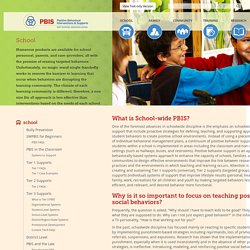
PBIS Student Survey. NJSCS MSHS Student Q. Why Restorative Practices Benefit All Students. Did you know that a significant percentage of the achievement gap between students of color and white students is caused by punitive discipline?
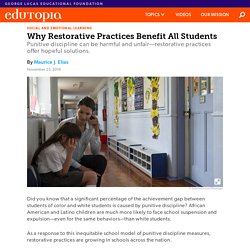
African American and Latino children are much more likely to face school suspension and expulsion—even for the same behaviors—than white students. As a response to this inequitable school model of punitive discipline measures, restorative practices are growing in schools across the nation. Defining Restorative - IIRP Graduate School. Amstutz, L.
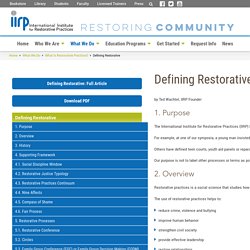
S., & Zehr, H. (1998). Victim offender conferencing in Pennsylvania’s juvenile justice system. Retrieved from. Case Examples. Jonesboro Middle School Case Jonesboro Middle School (JMS) has a population of 558 students, a 65% poverty rate and sits in the center of Clayton County, Georgia.
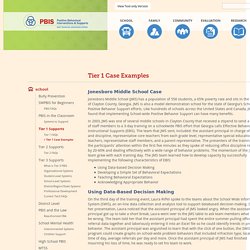
JMS is also a model demonstration school for the state of Georgia's Schoolwide Positive Behavior Support efforts. Like hundreds of schools across the United States and Canada, JMS has found that implementing School-wide Positive Behavior Support can have many benefits. Find What Works! The What Works Clearinghouse (WWC) reviews the existing research on different programs, products, practices, and policies in education. Our goal is to provide educators with the information they need to make evidence-based decisions. We focus on the results from high-quality research to answer the question “What works in education?”
Find more information about the WWC. The What Works Clearinghouse (WWC) reviews the existing research on different programs, products, practices, and policies in education. Our goal is to provide educators with the information they need to make evidence-based decisions. Hinsdale Central High School. All students should feel competent to handle their interpersonal conflicts in a productive manner.
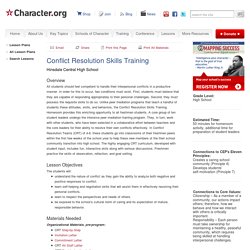
In order for this to occur, two conditions must exist. First, students must believe that they are capable of responding appropriately to their personal challenges. Second, they must possess the requisite skills to do so. Unlike peer mediation programs that teach a handful of students these attitudes, skills, and behaviors, the Conflict Resolution Skills Training Homeroom provides this enriching opportunity to all freshmen students. A core group of ten student leaders undergo the intensive peer mediation training program. 1. 2. 3. Gather feedback immediately on the homeroom event from CRT student leaders and the homeroom teachers. Gmail - Free Storage and Email from Google. PBIS Assessment Surveys. PBIS Assessment includes surveys for research, for annual assessment and for progress monitoring of SWPBIS.
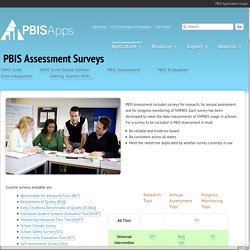
Each survey has been developed to meet the data requirements of SWPBIS usage in schools. For a survey to be included in PBIS Assessment it must: Be reliable and evidence-basedBe consistent across all statesMeet the needs not duplicated by another survey currently in use Benchmarks for Advanced Tiers (BAT) Who: Teams who have consistently scored 80% or higher on the MATT when assessing their Tier II and III implementation may consider moving to the annual BAT survey. When: Annually The BAT (PDF) allows school teams to self-assess the implementation status primarily of Tiers II and III behavior support systems within their school. Are the organizational elements in place for implementing secondary and tertiary behavior support practices? The teams involved with Tier II and Tier III supports along with their coach complete the BAT during a team meeting. PBISWorld.com Home Page. Dignity in Schools Campaign Publications and Tools.
SWPBIS for Beginners. ModelCode Section3.1b Model1. Model Code by Section. Printer-friendly versionSend to friend Download the Full Mode Code or Executive Summary Download the the Model Code by Section: 1.1 Fulfilling the Full Potential of Children and Youth 1.2 Ensuring Equity in Education 2.1 Stakeholder Participation.
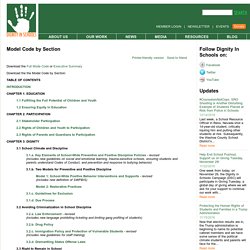
DSC Model Code Exec Summary. Climate Change: Implementing School Discipline Practices That Create a Positive School Climate. OutofSchool-OffTrack_UCLA_4-8. 8 Tips for Schools Interested in Restorative Justice. Restorative justice is an effective alternative to punitive responses to wrongdoing.

Inspired by indigenous traditions, it brings together persons harmed with persons responsible for harm in a safe and respectful space, promoting dialogue, accountability, and a stronger sense of community. Restorative justice is a philosophical framework that can be applied in a variety of contexts -- the justice system, schools, families, communities, and others.